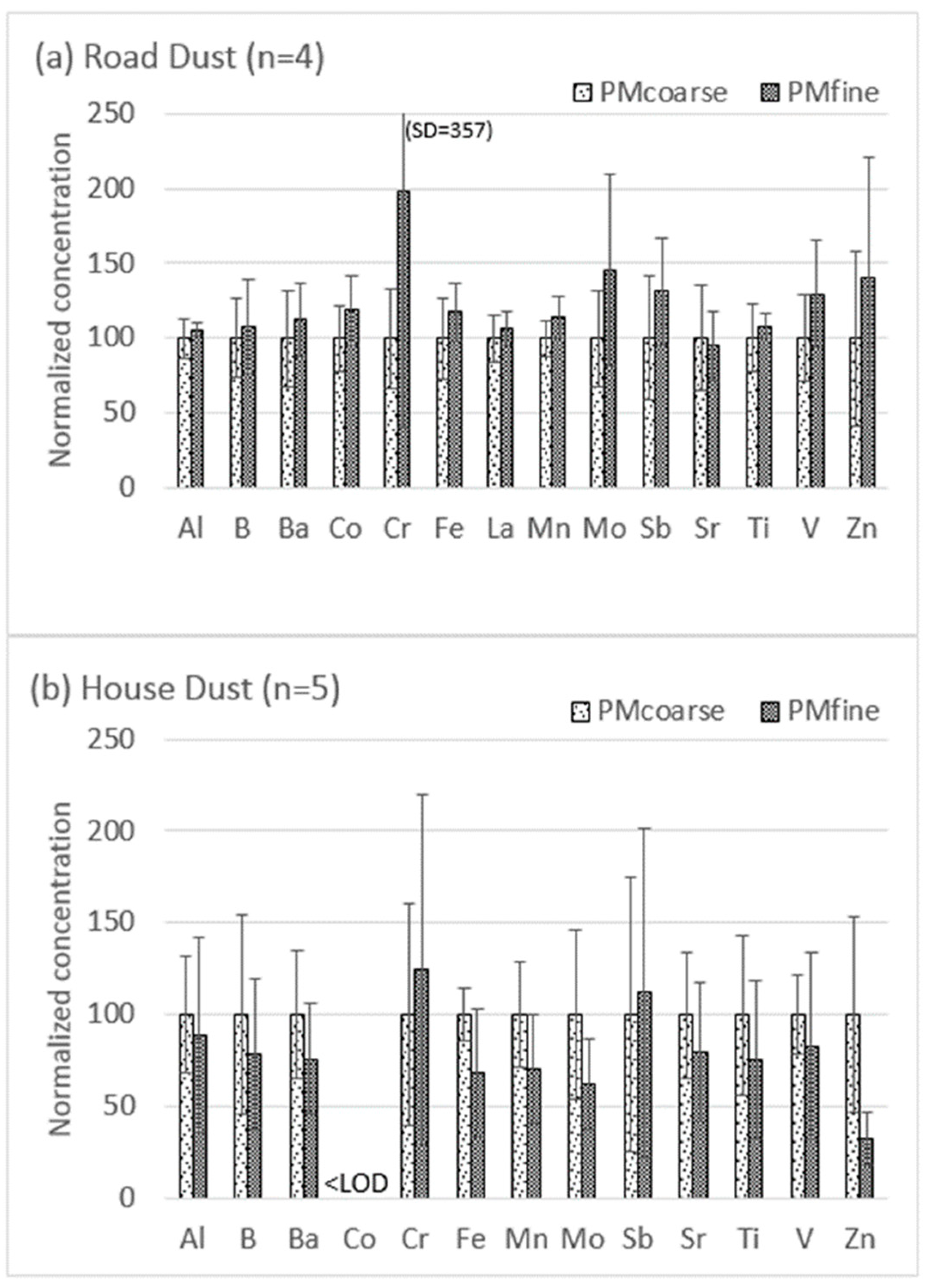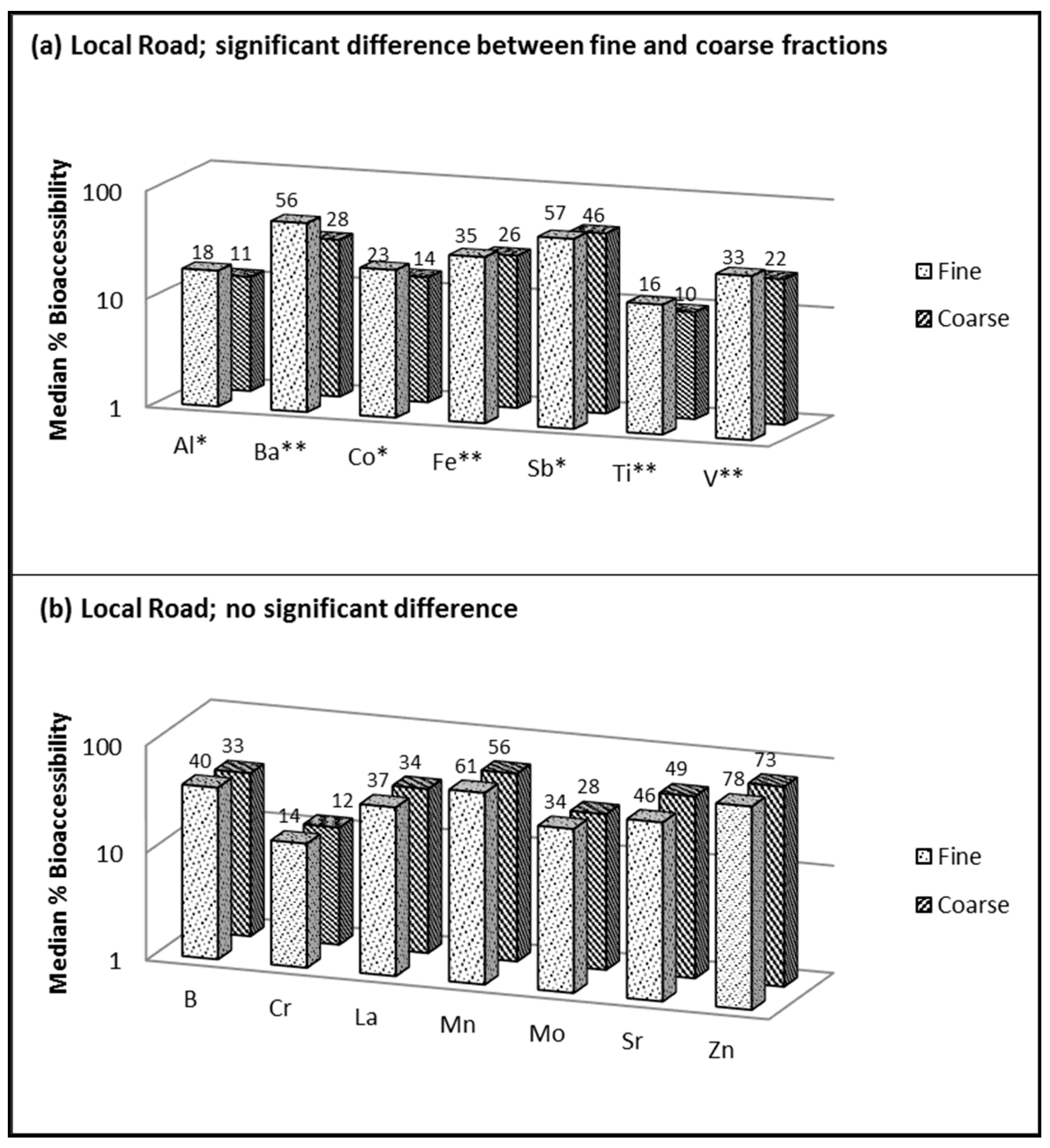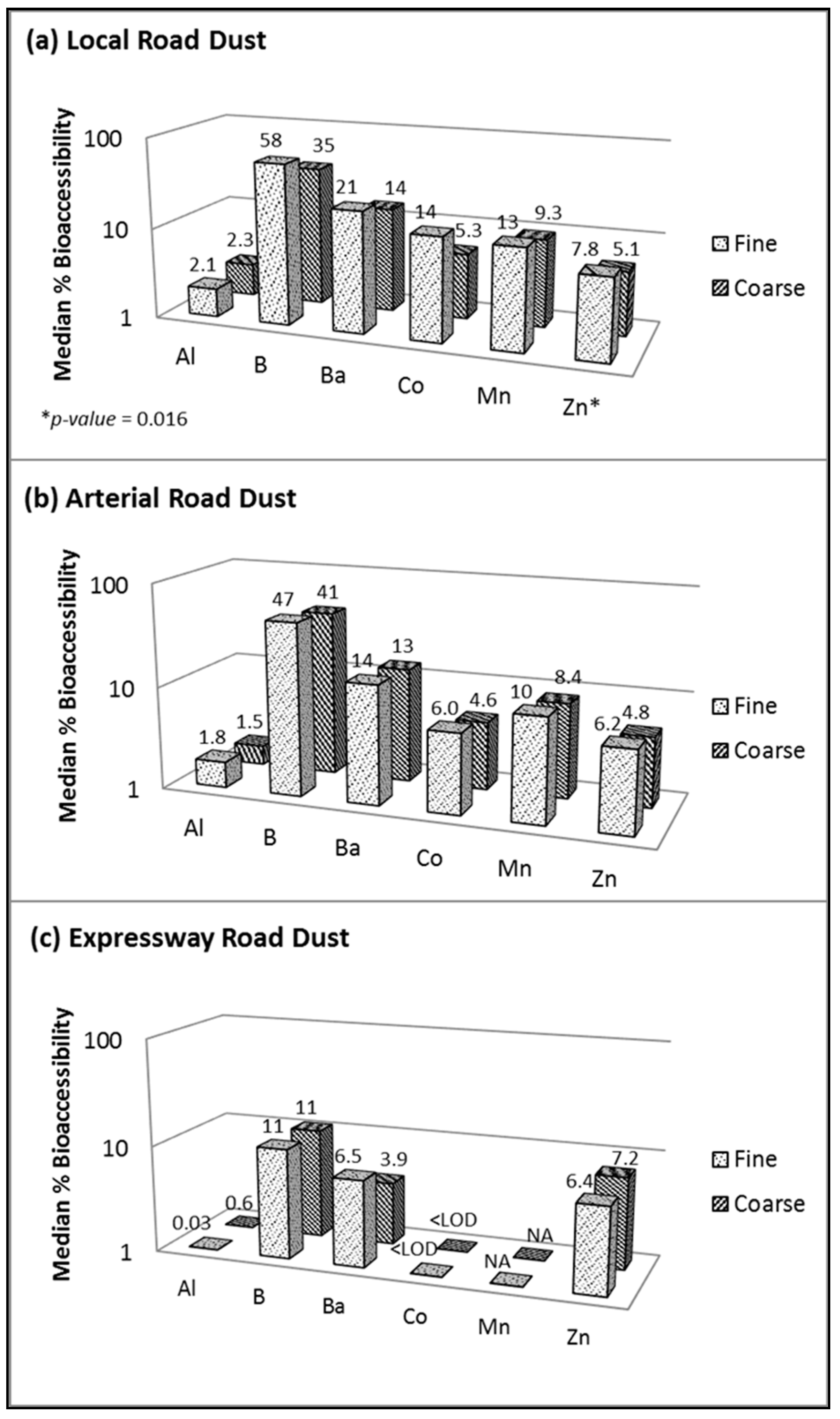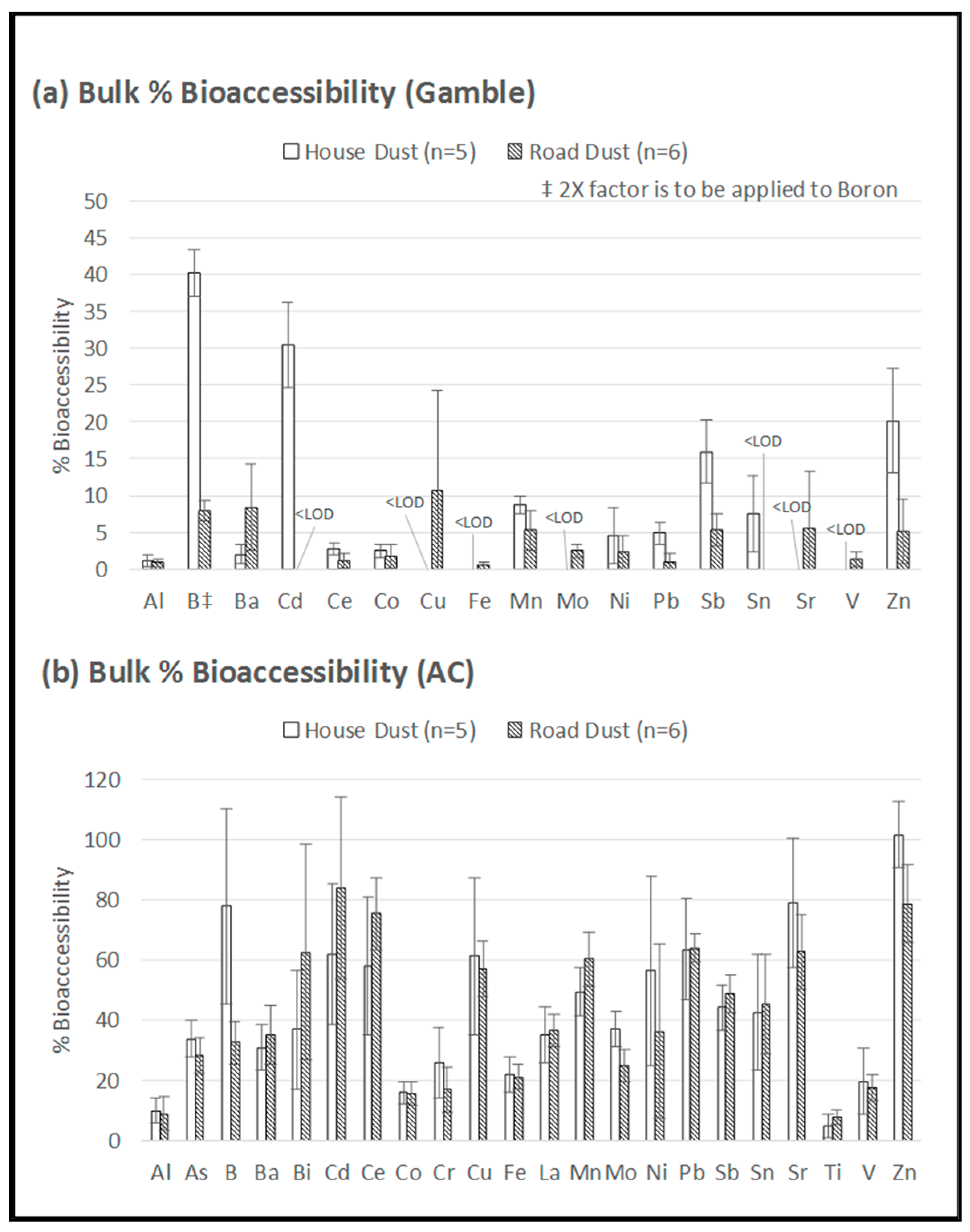Thoracic Fraction (PM10) of Resuspended Urban Dust: Geochemistry, Particle Size Distribution and Lung Bioaccessibility
Abstract
1. Introduction
2. Materials and Methods
2.1. Sample Collection and Preparation
2.1.1. Aerosolization and Size Fractionation
2.1.2. Gravimetric Measurements
2.2. Sample Digestion and Analysis
2.2.1. Reagents, Standards and Certified Reference Materials
2.2.2. Total Element Digestion
2.2.3. Gamble Extraction
2.2.4. Ammonium Citrate (AC) Extraction
2.3. Elemental Determination
2.4. Calculations and Data Analysis
2.5. Quality Control
3. Results and Discussion
3.1. Road Dust and House Dust PM Mass Distribution Profiles
3.2. Total Element Concentrations in Fine versus Coarse Dust Fractions
3.3. Metal Bioaccessibility in Fine versus Coarse Dust Fractions
3.4. Metal Bioaccessibility in Bulk Samples of House Dust and Road Dust
4. Conclusions
Supplementary Materials
Author Contributions
Funding
Acknowledgments
Conflicts of Interest
References
- World Health Organization. Health Effects of Particulate Matter; World Health Organization: Geneva, Switzerland, 2013; 15p, ISBN 9789289000017. [Google Scholar]
- Kim, K.-H.; Kabir, E.; Kabir, S. A review on the human health impact of airborne particulate matter. Environ. Int. 2015, 74, 136–143. [Google Scholar] [CrossRef] [PubMed]
- Franklin, M.; Koutrakis, P.; Schwartz, P. The Role of Particle Composition on the Association between PM2.5 and Mortality. Epidemiology 2008, 19, 680–689. [Google Scholar] [CrossRef] [PubMed]
- Jin, L.; Xie, J.; Wong, C.K.C.; Chan, S.K.Y.; Abbaszade, G.; Schnelle-Kreis, J.; Zimmermann, R.; Li, J.; Zhang, G.; Fu, P.; et al. Contributions of City-Specific Fine Particulate Matter (PM2.5) to Differential In Vitro Oxidative Stress and Toxicity Implications between Beijing and Guangzhou of China. Environ. Sci. Technol. 2019, 53, 2881–2891. [Google Scholar] [CrossRef] [PubMed]
- Wiseman, C.L. Analytical methods for assessing metal bioaccessibility in airborne particulate matter: A scoping review. Anal. Chim. Acta 2015, 877, 9–18. [Google Scholar] [CrossRef] [PubMed]
- Khan, K.R.; Strand, A.M. Road dust and its effect on human health: A literature review. Epidemiol. Health 2018, 40, e2018013. [Google Scholar] [CrossRef] [PubMed]
- Hong, N.; Guan, Y.; Yang, B.; Zhong, J.; Zhu, P.; Ok, Y.S.; Hou, D.; Tsang, D.C.; Guan, Y.; Liu, A. Quantitative source tracking of heavy metals contained in urban road deposited sediments. J. Hazard. Mater. 2020, 393, 122362. [Google Scholar] [CrossRef]
- Pant, P.; Harrison, R.M. Estimation of the contribution of road traffic emissions to particulate matter concentrations from field measurements: A review. Atmos. Environ. 2013, 77, 78–97. [Google Scholar] [CrossRef]
- Logiewa, A.; Miazgowicz, A.; Krennhuber, K.; Lanzerstorfer, C. Variation in the Concentration of Metals in Road Dust Size Fractions Between 2 μm and 2 mm: Results from Three Metallurgical Centres in Poland. Arch. Environ. Contam. Toxicol. 2020, 78, 46–59. [Google Scholar] [CrossRef]
- Van Der Gon, H.A.D.; Gerlofs-Nijland, M.E.; Gehrig, R.; Gustafsson, M.; Janssen, N.; Harrison, R.M.; Hulskotte, J.; Johansson, C.; Jozwicka, M.; Keuken, M.; et al. The Policy Relevance of Wear Emissions from Road Transport, Now and in the Future—An International Workshop Report and Consensus Statement. J. Air Waste Manag. Assoc. 2013, 63, 136–149. [Google Scholar] [CrossRef]
- Zereini, F.; Alsenz, H.; Wiseman, C.L.; Püttmann, W.; Reimer, E.; Schleyer, R.; Bieber, E.; Wallasch, M. Platinum group elements (Pt, Pd, Rh) in airborne particulate matter in rural vs. urban areas of Germany: Concentrations and spatial patterns of distribution. Sci. Total Environ. 2012, 416, 261–268. [Google Scholar] [CrossRef] [PubMed]
- Angelé-Martínez, C.; Goodman, C.; Brumaghim, J. Metal-mediated DNA damage and cell death: Mechanisms, detection methods, and cellular consequences. Metallomics 2014, 6, 1358–1381. [Google Scholar] [CrossRef] [PubMed]
- Abbasi, S.; Keshavarzi, B.; Moore, F.; Hopke, P.K.; Kelly, F.J.; Dominguez, A.O. Elemental and magnetic analyses, source identification, and oxidative potential of airborne, passive, and street dust particles in Asaluyeh County, Iran. Sci. Total Environ. 2020, 707, 136132. [Google Scholar] [CrossRef] [PubMed]
- Padoan, E.; Romè, C.; Ajmone-Marsan, F. Bioaccessibility and size distribution of metals in road dust and roadside soils along a peri-urban transect. Sci. Total Environ. 2017, 89–98. [Google Scholar] [CrossRef] [PubMed]
- Pelfrêne, A.; Cave, M.R.; Wragg, J.; Douay, F. In Vitro Investigations of Human Bioaccessibility from Reference Materials Using Simulated Lung Fluids. Int. J. Environ. Res. Public Health 2017, 14, 112. [Google Scholar] [CrossRef] [PubMed]
- Caboche, J.; Perdrix, E.; Malet, B.; Laurent, Y.A. Development of an in vitro method to estimate lung bioaccessibility of metals from atmospheric particles. J. Environ. Monit. 2011, 13, 621–630. [Google Scholar]
- Wragg, J.; Cave, M. Assessment of a geochemical extraction procedure to determine the solid phase fractionation and bioaccessibility of potentially harmful elements in soils: A case study using the NIST 2710 reference soil. Anal. Chim. Acta 2012, 722, 43–54. [Google Scholar] [CrossRef] [PubMed]
- Kastury, F.; Smith, E.; Juhasz, A.L. A critical review of approaches and limitations of inhalation bioavailability and bioaccessibility of metal(loid)s from ambient particulate matter or dust. Sci. Total Environ. 2017, 574, 1054–1074. [Google Scholar] [CrossRef] [PubMed]
- Mukhtar, A.; Mohr, V.; Limbeck, A. The suitability of extraction solutions to assess bioaccessible trace metal fractions in airborne particulate matter: A comparison of common leaching agents. Environ. Sci. Pollut. Res. 2015, 22, 16620–16630. [Google Scholar] [CrossRef] [PubMed]
- Terzano, C.; Di Stefano, F.; Conti, V.; Graziani, E.; Petroianni, A. Air pollution ultrafine particles: Toxicity beyond the lung. Eur. Rev. Med. Pharmacol. Sci. 2010, 14, 809–821. [Google Scholar] [PubMed]
- Broadway, A.; Cave, M.R.; Wragg, J.; Fordyce, F.M.; Bewley, R.J.; Graham, M.C.; Ngwenya, B.T.; Farmer, J.G. Determination of the bioaccessibility of chromium in Glasgow soil and the implications for human health risk assessment. Sci. Total Environ. 2010, 409, 267–277. [Google Scholar] [CrossRef]
- Ljung, K.; Siah, W.S.; Devine, B.; Maley, F.; Wensinger, A.; Cook, A.; Smirk, M. Extracting dust from soil: Improved efficiency of a previously published process. Sci. Total Environ. 2011, 410411, 269–270. [Google Scholar] [CrossRef]
- Guney, M.; Chapuis, R.P.; Zagury, G.J. Lung bioaccessibility of contaminants in particulate matter of geological origin. Environ. Sci. Pollut. Res. 2016, 23, 24422–24434. [Google Scholar] [CrossRef] [PubMed]
- Rasmussen, P.E.; Levesque, C.; Chénier, M.; Gardner, H.D. Contribution of metals in resuspended dust to indoor and personal inhalation exposures: Relationships between PM10 and settled dust. Build. Environ. 2018, 143, 513–522. [Google Scholar] [CrossRef]
- Stopford, W.; Turner, J.; Cappellini, D.; Brock, T. Bioaccessibility testing of cobalt compounds. J. Environ. Monit. 2003, 5, 675–680. [Google Scholar] [CrossRef] [PubMed]
- Midander, K.; Pan, J.; Wallinder, I.O.; Leygraf, C. Metal release from stainless steel particles in vitro—Influence of particle size. J. Environ. Monit. 2007, 9, 74–81. [Google Scholar] [CrossRef] [PubMed]
- Thomassen, Y.; Nieboer, E.; Romanova, N.; Nikanov, A.; Hetland, S.; VanSpronsen, E.P.; Odland, J.Ø.; Chashchine, V. Multi-component assessment of worker exposures in a copper refinery Part 1. Environmental monitoring. J. Environ. Monit. 2004, 6, 985–991. [Google Scholar] [CrossRef] [PubMed]
- Wiseman, C.L.; Niu, J.; Levesque, C.; Chénier, M.; Rasmussen, P.E. An assessment of the inhalation bioaccessibility of platinum group elements in road dust using a simulated lung fluid. Environ. Pollut. 2018, 241, 1009–1017. [Google Scholar] [CrossRef] [PubMed]
- Rasmussen, P.E.; Levesque, C.; Chénier, M.; Gardner, H.D.; Jones-Otazo, H.; Petrovic, S. Canadian House Dust Study: Population-based concentrations, loads and loading rates of arsenic, cadmium, chromium, copper, nickel, lead, and zinc inside urban homes. Sci. Total Environ. 2013, 443, 520–529. [Google Scholar] [CrossRef] [PubMed]
- Health Canada. Human Health Risk Assessment for Coarse Particulate Matter; Cat.: H144-30/2016E-PDF, Pub.: 150213; Water and Air Quality Bureau, Health Canada, Government of Canada: Ottawa, ON, Canada, 2016; 289p, ISBN 978-0-660-04440-8.
- Rasmussen, P.E.; MacIntyre, D.J.; Guenette, J. Buoyancy-Corrected Gravimetric Analysis System. U.S. Patent US 7,357,045 B2, 15 April 2008. [Google Scholar]
- Rasmussen, P.E.; Gardner, H.D.; Niu, J. Buoyancy-Corrected Gravimetric Analysis of Lightly Loaded Filters. J. Air Waste Manag. Assoc. 2010, 60, 1065–1077. [Google Scholar] [CrossRef]
- Niu, J.; Rasmussen, P.E.; Chénier, M. Ultrasonic dissolution for ICP-MS determination of trace elements in lightly loaded airborne PM filters. Int. J. Environ. Anal. Chem. 2013, 93, 661–678. [Google Scholar] [CrossRef]
- Dodd, M.; Rasmussen, P.E.; Chénier, M. Comparison of Two In Vitro Extraction Protocols for Assessing Metals’ Bioaccessibility Using Dust and Soil Reference Materials. Hum. Ecol. Risk Assess. Int. J. 2013, 19, 1014–1027. [Google Scholar] [CrossRef]
- Boros, K.; Fortin, D.; Jayawardene, I.; Chénier, M.; Levesque, C.; Rasmussen, P.E. Comparison of Gastric versus Gastrointestinal PBET Extractions for Estimating Oral Bioaccessibility of Metals in House Dust. Int. J. Environ. Res. Public Health 2017, 14, 92. [Google Scholar] [CrossRef]
- Avramescu, M.-L.; Rasmussen, P.E.; Chénier, M.; Gardner, H.D. Influence of pH, particle size and crystal form on dissolution behaviour of engineered nanomaterials. Environ. Sci. Pollut. Res. 2017, 24, 1553–1564. [Google Scholar] [CrossRef]
- Kasimov, N.S.; Kosheleva, N.E.; Vlasov, D.V.; Nabelkina, K.S.; Ryzhov, A.V. Physicochemical Properties of Road Dust in Moscow. Geogr. Environ. Sustain. 2019, 12, 96–113. [Google Scholar] [CrossRef]
- Gunawardana, C.; Goonetilleke, A.; Egodawatta, P.; Dawes, L.A.; Kokot, S. Source characterisation of road dust based on chemical and mineralogical composition. Chemosphere 2012, 87, 163–170. [Google Scholar] [CrossRef] [PubMed]
- Rasmussen, P.E.; Beauchemin, S.; Nugent, M.; Dugandzic, R.; Lanouette, M.; Chénier, M. Influence of Matrix Composition on the Bioaccessibility of Copper, Zinc, and Nickel in Urban Residential Dust and Soil. Hum. Ecol. Risk Assess. Int. J. 2008, 14, 351–371. [Google Scholar] [CrossRef]
- Kong, S.; Lu, B.; Ji, Y.; Zhao, X.; Bai, Z.; Xu, Y.; Liu, Y.; Jiang, H. Risk assessment of heavy metals in road and soil dusts within PM2.5, PM10 and PM100 fractions in Dongying city, Shandong Province, China. J. Environ. Monit. 2012, 14, 791–803. [Google Scholar] [CrossRef] [PubMed]
- Bari, A.; Kindzierski, W.B.; Wallace, L.A.; Wheeler, A.J.; MacNeill, M.; Héroux, M.-È. Indoor and Outdoor Levels and Sources of Submicron Particles (PM1) at Homes in Edmonton, Canada. Environ. Sci. Technol. 2015, 49, 6419–6429. [Google Scholar] [CrossRef] [PubMed]
- Yoshinaga, J.; Yamasaki, K.; Yonemura, A.; Ishibashi, Y.; Kaido, T.; Mizuno, K.; Takagi, M.; Tanaka, A. Lead and other elements in house dust of Japanese residences—Source of lead and health risks due to metal exposure. Environ. Pollut. 2014, 189, 223–228. [Google Scholar] [CrossRef]
- Brehmer, C.; Norris, C.; Barkjohn, K.K.; Bergin, M.H.; Zhang, J.; Cui, X.; Zhang, Y.; Black, M.; Li, Z.; Shafer, M.; et al. The impact of household air cleaners on the chemical composition and children’s exposure to PM2.5 metal sources in suburban Shanghai. Environ. Pollut. 2019, 253, 190–198. [Google Scholar] [CrossRef]
- Meza-Figueroa, D.; Barboza-Flores, M.; Romero, F.M.; Acosta-Elias, M.; Hernández-Mendiola, E.; Maldonado-Escalante, F.; Pérez-Segura, E.; González-Grijalva, B.; Meza-Montenegro, M.; García-Rico, L.; et al. Metal bioaccessibility, particle size distribution and polydispersity of playground dust in synthetic lysosomal fluids. Sci. Total Environ. 2020, 713, 136481. [Google Scholar] [CrossRef] [PubMed]





| Order of Addition | Chemical | Chemical Formula | Supplier Information | Mass (g) |
|---|---|---|---|---|
| 1 | Magnesium chloride hexahydrated | MgCl2·6H2O | Sigma-Aldrich; Cat. No. 255777 | 0.2033 |
| 2 | Sodium chloride | NaCl | Fluka; Cat. No. 71379 | 6.0193 |
| 3 | Potassium chloride | KCl | Sigma-Aldrich; Cat. No. P9541 | 0.2892 |
| 4 | Disodium hydrogen phosphate | Na2HPO4 | Sigma-Aldrich; Cat. No. 795410 | 0.1260 |
| 5 | Sodium sulphate | Na2SO4 | Sigma-Aldrich; Cat. No. 204447 | 0.0710 |
| 6 | Calcium chloride dihydrate | CaCl2·6H2O | Sigma-Aldrich; Cat. No. 470872 | 0.3676 |
| 7 | Sodium acetate | C2H3O2Na·3H2O | Sigma-Aldrich; Cat. No. 32318 | 0.9526 |
| 8 | Sodium hydrogen carbonate | NaHCO3 | Sigma-Aldrich; Cat. No. S-6014 | 2.6043 |
| 9 | Sodium citrate dihydrate | C6H5Na3O7·2H2O | Sigma-Aldrich; Cat. No. S1804 | 0.0970 |
| Modified Gamble | Ammonium Citrate | Total Digestion | |||||||||||
|---|---|---|---|---|---|---|---|---|---|---|---|---|---|
| Certified | LOD * | Observed * | RSD | Bioaccessibility | LOD * | Observed * | RSD | Bioaccessibility | LOD ‡ | Observed ¥ | RSD | Recovery | |
| mg/kg | mg/kg | mg/kg | % | % | mg/kg | mg/kg | % | % | mg/kg | mg/kg | % | % | |
| Aluminum | 23,200 ± 600 | 9.42 | 240 | 31.0 | 1 | 7.29 | 1493 | 8.80 | 6 | 35.0 | 22,656 | 7.99 | 98 |
| Antimony | 14 | 1.49 | 2.42 | 39.8 | 17 | 0.95 | 4.68 | 8.11 | 33 | 4.11 | 11.9 | 20.2 | 85 |
| Arsenic | 17.4 ± 4.2 | 24.9 | 2.27 | 74.6 | 13 | 1.23 | 7.41 | 4.61 | 43 | 0.40 | 16.4 | 11.1 | 94 |
| Barium | 1300 | 19.4 | 35.6 | 60.7 | 3 | 1.96 | 349 | 2.44 | 27 | 1.28 | 1384 | 7.87 | 106 |
| Bismuth | 9 | 0.84 | <LOD | - | - | 1.52 | 4.98 | 12.9 | 55 | 2.50 | 7.69 | 13.2 | 85 |
| Boron | NA | 3.40 | 1439 | 19.4 | NA | 2.15 | 1020 | 5.96 | NA | 7.19 | 1231 | 7.17 | NA |
| Cadmium | 10.0 ± 1.1 | 0.58 | 3.20 | 22.6 | 32 | 1.28 | 6.07 | 6.31 | 61 | 0.19 | 7.67 | 11.5 | 77 |
| Cerium | 35 | 0.89 | 1.11 | 51.6 | 3 | 0.94 | 16.1 | 7.81 | 46 | 0.10 | 38.6 a | 13.9 | 110 |
| Chromium | 135.0 ± 9.1 | 94.7 | <LOD | - | - | 0.22 | 19.7 | 41.6 | 15 | 11.9 | 127 | 30.5 | 94 |
| Cobalt | 10 | 1.07 | 2.01 | 42.4 | 20 | 1.23 | 3.23 | 11.5 | 32 | 0.10 | 9.56 a | 9.73 | 96 |
| Copper | 320 | 50.2 | 23.0 | 55.7 | 7 | 1.21 | 144 | 23.2 | 45 | 4.88 | 309 | 25.9 | 96 |
| Iron | 16,400 ± 1200 | 603 | <LOD | - | - | 35.7 | 2109 | 10.1 | 13 | 396 | 14,395 | 8.23 | 88 |
| Lanthanum | 19 ± 2 | 0.79 | 0.40 | 54.8 | 2 | 1.09 | 3.75 | 13.4 | 20 | 0.08 | 14.0 | 20.8 | 74 |
| Lead | 9761 ± 67 | 1.01 | 560 | 26.5 | 6 | 1.41 | 7983 | 7.96 | 82 | 0.65 | 9292 | 6.43 | 95 |
| Manganese | 370 | 1.04 | 61.4 | 24.0 | 17 | 1.68 | 190 | 8.43 | 51 | 1.11 | 343 | 9.15 | 93 |
| Molybdenum | 5.5 | 1.14 | 0.61 | 56.6 | 11 | 1.05 | 0.91 | 28 | 17 | 2.03 | 4.69 | 31.1 | 85 |
| Nickel | 90 | 7.18 | 6.49 | 79.3 | 7 | 1.20 | 20.4 | 29.7 | 23 | 1.42 | 84.6 | 25.2 | 94 |
| Strontium | 160 | 204 | <LOD | - | - | 5.53 | 63.8 | 25.3 | 40 | 2.82 | 163 | 9.87 | 102 |
| Tin | NA | 2.26 | <LOD | - | - | 0.99 | 12.8 | 58.3 | NA | 1.00 | 28.7 a | 29.3 | NA |
| Titanium | 4200 ± 300 | 47.5 | <LOD | - | - | 1.76 | 39.5 | 4.17 | 0.9 | 100 | 3860 a | 10.7 | 92 |
| Vanadium | 34 | 18.2 | 1.10 | 79.3 | 3 | 0.16 | 4.32 | 38.3 | 13 | 0.28 | 32.6 | 7.09 | 96 |
| Zinc | 2580 ± 150 | 18.9 | 380 | 24.1 | 15 | 13.4 | 1811 | 4.18 | 70 | 21.9 | 2426 | 10.8 | 94 |
Publisher’s Note: MDPI stays neutral with regard to jurisdictional claims in published maps and institutional affiliations. |
© 2021 by the authors. Licensee MDPI, Basel, Switzerland. This article is an open access article distributed under the terms and conditions of the Creative Commons Attribution (CC BY) license (http://creativecommons.org/licenses/by/4.0/).
Share and Cite
Levesque, C.; Wiseman, C.L.S.; Beauchemin, S.; Rasmussen, P.E. Thoracic Fraction (PM10) of Resuspended Urban Dust: Geochemistry, Particle Size Distribution and Lung Bioaccessibility. Geosciences 2021, 11, 87. https://doi.org/10.3390/geosciences11020087
Levesque C, Wiseman CLS, Beauchemin S, Rasmussen PE. Thoracic Fraction (PM10) of Resuspended Urban Dust: Geochemistry, Particle Size Distribution and Lung Bioaccessibility. Geosciences. 2021; 11(2):87. https://doi.org/10.3390/geosciences11020087
Chicago/Turabian StyleLevesque, Christine, Clare L. S. Wiseman, Suzanne Beauchemin, and Pat E. Rasmussen. 2021. "Thoracic Fraction (PM10) of Resuspended Urban Dust: Geochemistry, Particle Size Distribution and Lung Bioaccessibility" Geosciences 11, no. 2: 87. https://doi.org/10.3390/geosciences11020087
APA StyleLevesque, C., Wiseman, C. L. S., Beauchemin, S., & Rasmussen, P. E. (2021). Thoracic Fraction (PM10) of Resuspended Urban Dust: Geochemistry, Particle Size Distribution and Lung Bioaccessibility. Geosciences, 11(2), 87. https://doi.org/10.3390/geosciences11020087






